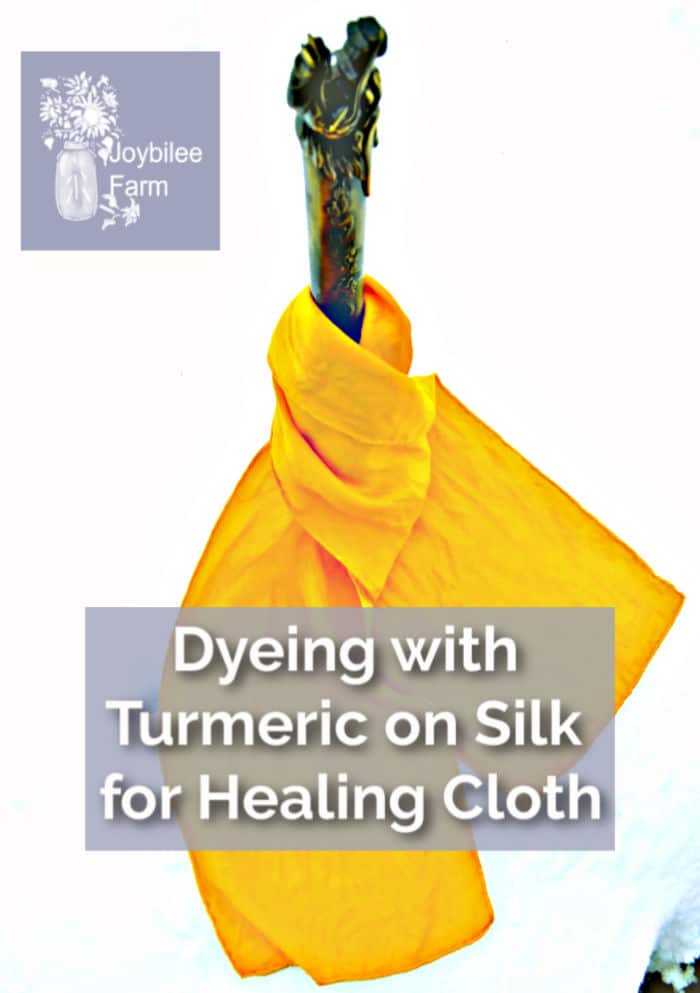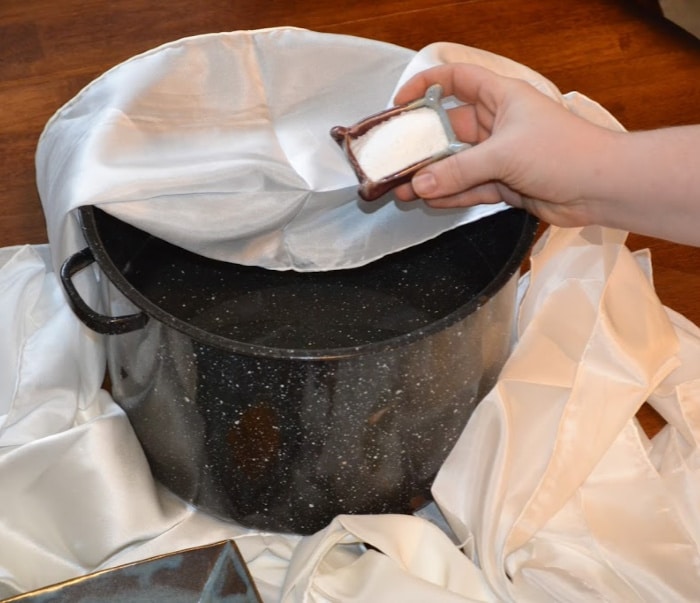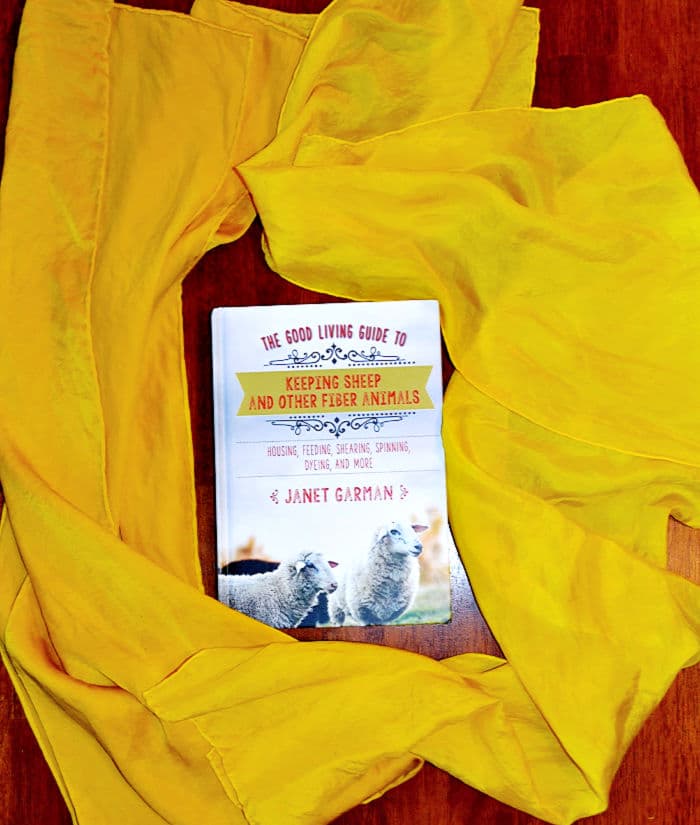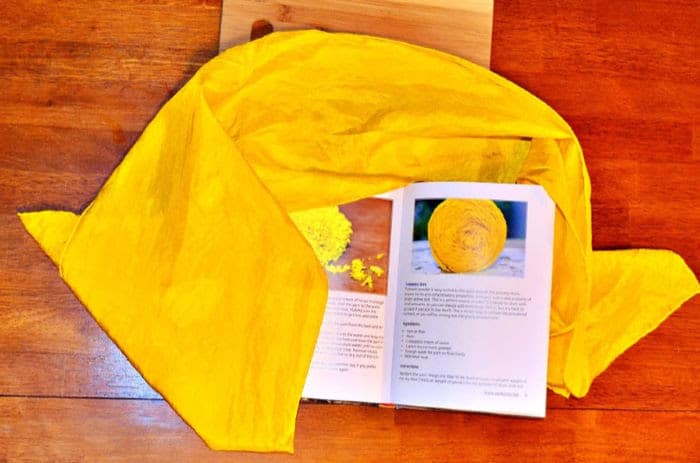Dyeing with turmeric is an easy way to give bright, sunny color to any natural fiber. The dyeing process is easy and quick enough for an afternoon project. Turmeric gives a bright, warm, yellow color to any natural fiber. It is mostly colorfast, and the best thing is that you only need as much as you’d put in a curry, to create a vibrant golden silk scarf.
In the dull, dark days of winter, turmeric can be the ticket to bringing the sunshine back. Turmeric is the deep yellow curry spice, but it’s also used medicinally as an anti-inflammatory. Even if you’ve used turmeric medicinally and in cooking you may not know of it’s colorful natural dye qualities. While not as colorfast as saffron or weld, two historically used natural dyes, turmeric is a powerful natural dye in its own right.

Did you know that just as you can find herbal medicines in your spice cupboard, you can also find easy to use natural dyes. In fact the constituents that make spices therapeutic and healing are the same constituents that give vibrant natural dye colors to fabric. Turmeric, for instance is anti-inflammatory and antioxidant. A silk scarf dyed with turmeric sparkles with golden color. Turmeric is one of the less fugitive yellow natural dyes, with a rich gold to orange tone on silk. After dyeing, the fabric may retain the faint perfume-y scent of the spice, even after a few washings. This “turmeric fragrance” is may even make the cloth therapeutic.
There are many other herbs you can use directly on fabric for a similar effect. Like this leaf print blanket demonstrates.
Healing Cloth
In Ayurvedic medicine, turmeric dyed cloth is used for it’s anti-inflammatory and pain relieving qualities in clinics. Our skin is our largest organ. What we put on our skin is absorbed into our body. This can increase if the cloth is damp. Chemical dyes can be problematic, but natural dyes can be used to make healing cloth that targets specific ailments, based on the plants, herbs, and spices used in dyeing. Doing your own dyeing with turmeric enables you to experience some of turmeric’s healing benefits simply through wearing cloth dyed with it.
Print
Dyeing with Turmeric on Silk for Healing Cloth
Description
Naturally dye your own silk scarf with turmeric.
Ingredients
What you need:
- 1 teaspoon Alum
- 1 teaspoon Turmeric
- A silk scarf that’s ready to dye
- A dye pot (one that is not used for food, and is non-reactive)
- Gloves
Instructions
- Dissolve alum in warm water in your dye vat
- Wash silk scarf blank in warm water with a dash of soap, rinse well.
- Soak the silk blank in the alum water for at least 1 hour, or overnight
- Remove silk from alum and reserve mordant water for reuse.
- Fill dye pot halfway with warm water and add turmeric powder.
- Bring to a simmer, take off heat and add your silk scarf.
- Soak silk in the dye vat for at least 30 minutes, stirring every 10. You can soak longer if desired.
- Remove silk and rinse the scarf under warm running water.
- Dry and iron the silk scarf and enjoy.
- Dispose of the used dye vat in your compost pile, or other safe disposal.
What you need:
- 1 teaspoon Alum
- 1 teaspoon Turmeric
- A silk scarf that’s ready to dye
- A dye pot (one that is not used for food, and is non-reactive)
- Gloves
Dyeing with Turmeric:
First off, give your scarf blank or other item a quick wash with warm soapy water. This removes any oils or residues from the fabric processing, and helps make sure your turmeric dye will give even coverage. Make sure you rinse your scarf blank till there is no soap residue.
If you know the weight of your scarf blank, weigh out 10% of the weight in alum. If you have 100 grams of fabric weigh out 10 grams of alum. Turmeric dye is one of the most colorfast natural yellows.

Dissolve the alum in hot water in your dye pot. Soak the scarf for an hour in the dye pot. You don’t need to heat the water. The residual heat from the hot water is enough. Too much heat can damage the silk fabric. You can pour the cooled alum water into a plastic pail and save it for future dyeing experiments. I prefer to reuse mordant water, to help conserve water and also because all the alum is not always absorbed from the water. Alum is non-toxic, but it is also a metal salt, reusing the mordant water makes sense.
Wear gloves whenever you add or remove the blank from the mordant, or from the dye bath. The alum can be drying and irritating to the skin. Wear gloves when rinsing off the turmeric dyed blank for the first time, as turmeric will stain your skin.
Fill your dye pot half full with fresh hot water. Add 1 teaspoon of turmeric powder. Simmer the dye pot over medium heat until the temperature of the dye vat is just below boiling. Remove the dye pot from the heat. Add your silk scarf to the dye vat. Cover the pot to hold in the heat. Let the silk scarf soak in the dye vat for 1 hour. Periodically stir the scarf in the vat to evenly color the scarf. Silk tends to float on the top of the vat and will need to be stirred around to allow for even coverage.

After the scarf reaches one or two degrees darker than you want it to be, pull out the scarf and thoroughly rinse off any turmeric powder that is stuck to the fabric. Let the scarf dry and evaluate the color. If you still like it, wash the scarf with mild soap. Hang to dry. Iron it to fully set the dye and get it ready to wear.
If the color is too light, or you are not satisfied with it, you can put the scarf back in the dye vat. To deepen the golden color add up to a tablespoon more turmeric to your dye vat and repeat the dye process.
Note: One scarf may not fully exhaust the color potential from the vat, particularly if you added more turmeric. You can dye woolen yarns, and any linen, cotton, wool, silk, or rayon object with natural dyes. It is also safe to add alum to the dye pot, if you decide to exhaust the vat by adding a large non-mordanted object (like a second-hand sheet or table cloth).
On average, if you set up a dye vat to give the darkest shade on 100 gms of wool, you can dye an additional 200-300 grams of wool varying lighter shades of the same color, from the same vat. This does require some experimentation to make sure you are getting the most out of your natural dye colors.
When you are finished with your dye vat, please discard it safely into your compost pile. Turmeric is safe for your compost, and so is a low level of alum.

Inspiration
If you grow any of your own fiber, washed fleece, wool roving, and spun yarns can all be colored with turmeric dye. Natural dyes are a fun way to make your own clothing, and accessories, more environmentally sustainable, healthy, and beautiful. Recently I was reading Janet Garman’s book, The Good Living Guide To Keeping Sheep And Other Fiber Animals. In her book, homesteader and fiber artist, Janet Garman teaches you necessary husbandry skills specifically tailored to fleece producing animals like sheep, llamas, alpacas, angora goats, and angora rabbits. I was interviewed for the llama chapter in this book. She then shows you step by step how to turn this raw fleece into yarn or felt to use in making clothing or crafts.
While the book focuses on different fiber animals for your homestead flock, it also has a subsection on what to do with the fiber after you shear it. Whether you are working with washed wool or raw wool, you’ll find inspiration in this book. Home grown fiber is sustainable, and an environmentally friendly way to clothe yourself and decorate your home.

The book also includes a brief section on natural dyes, with an emphasis on local natural dye colors from the garden. While the recipes are for dyeing yarn, it is easy to translate into fabric or washed wool. It is more fun to work with colorful fibers that plain white. The book’s recipe for dyeing with turmeric powder offers information on dyeing with wool. You’ll need more dye if you are dyeing silk. Silk is much thirstier than wool when it comes to natural dye colors. Use 1 gram of turmeric to dye 50 gms of wool a bright yellow. But you will need a larger amount of turmeric powder if you want to dye silk, or want the richer orange-yellow of pure turmeric to be on your fabric. After dyeing silk, or wool, to the darkest shade, you can continue dyeing with fresh scarves or fabric. The vat will give you lighter shades of yellow with each piece of fabric
To dig deeper into raising your own fiber animals buy Janet Garman’s book, The Good Living Guide To Keeping Sheep And Other Fiber Animals.
More Natural Dye Resources
To learn more about growing natural dyes and other herbs see these other resources.
Eco-printing with woad and weeds



Leave a Reply